RESEARCH & REFERENCES
Key References and Source Documents for the Study of Modern US Harbor Defenses
Prepared by Mark A. Berhow (berhowma@comcast.net)
Forty years ago, there was very little available on the history of general United States seacoast defense. Most of the material of interest lay in buried in the National Archives holdings, or in increasingly rare collections of old army publications on the bookshelves of some major libraries. There was nothing generally available in print– E. R. Lewis’ book had been published as a limited edition by the Smithsonian Press in 1970 but was soon sold out, other important works had been even longer out of print. Since then there has been a great expansion of original works, reprints, and photocopies of material on this subject, that make it possible to build a good general reference collection in personal or public libraries. This is a list of some of the publications and source documents used by researchers in the study of US Army seacoast defenses (1781-1947).
Link to additional CDSG listing of reference materials on specific forts and locations.
Download PDF of CDSG Listing of Reference Materials
The CDSG has published a number of reference guides to the holdings of the National Archives. One of these guides have been reproduced as a web page: Basic Research in Textual Records at the National Archives.
An excellent guide to doing research in the National Archives and Records Administration holdings is Environmental Cleanup at Former and Current Military Sites: A Guide to Research (EP-870-1-64), USACE, Historical Division, Office of the Chief of Engineers, GPO, Washington, DC, 2001). This book can be downloaded as PDF files from the Office’s publications page- http://www.usace.army.mil/ The CDSG publications, both the Coast Defense Journal and the CDSG Newsletter have a long series of excellent articles on the coast defense past.
Introductory Works
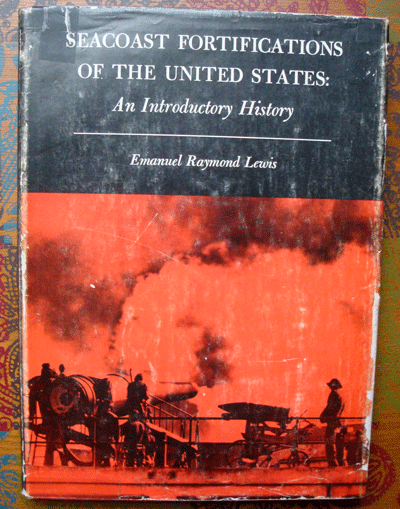
.
Seacoast Fortifications of the United States, an Introductory History, by Emanuel R. Lewis, Naval Institute Press, Annapolis, MD 1970, 1992. The one and only general history of seacoast defenses of the United States. This short text of 145 pages is well written and profusely illustrated. The book covers the entire history of United States seacoast artillery defense. Lewis discusses defense traditions, tactics and techniques in the introduction, then goes on discusses the US seacoast fortifications in the body of the book-the colonial beginnings, the First, Second and Third Systems, the Civil War years and after, the modern era construction of the Endicott, Taft, post WW I, and the WW II programs, and the remnants that remain today. Paperback is currently available from the Naval Institute Press,
www.nip.org.
Defending America’s Coasts 1775-1950, by Dale E. Floyd, Office of History, United States Army Corps of Engineers EP 870-1-57, Alexandria, VA, Government Printing Office, Washington, DC, 1997. This book can be downloaded as PDF files from the Office’s publications page-http://www.usace.army.mil. This is an excellent general bibliography of books, manuals, and articles written about US seacoast defenses. This supercedes a previous version of this work United States Coast Defense, 1775-1950, (EP 870-1-15), 1985.
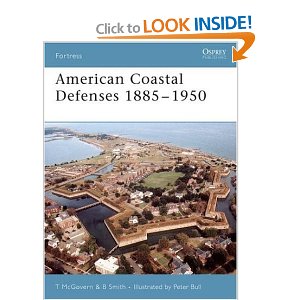
.
American Coastal Defenses 1885-1950 by Terrance McGovern and Bolling Smith. This introduction to the purpose, development, and eventual abandonment of American coastal defenses in the modern concrete era – characterized by the use of powerful breech-loading rifles and mortars mounted in earth and concrete batteries – covers the emplacements, weapons, and equipment, as well as the men who defended their country in peace and war. Available from Amazon.com.
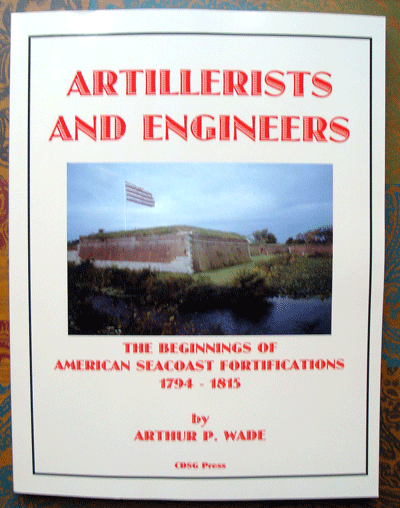
.
Artillerists and Engineers: The Beginnings of American Seacoast Fortifications, 1794-1815
by Arthur P. Wade, the best source of information on the First and Second Systems of American fortifications. Originally
written as a PhD Thesis in 1971, it has now been published as a paperback by the CDSG Press and is available from lulu.com.

.
NEW Second Edition-A Legacy in Brick and Stone: American Coastal Defense Forts of the Third System 1816-1867, By John R. Weaver II, Second Edition, Redoubt Press, 2018. An introduction to the brick and stone forts of the American Third System harbor defense fortifications built between 1816 and 1867. A study of the history of the Coastal Fortifications Board and describes the particular architectural components that were key to their design. Approximately two-thirds of this volume is dedicated to an illustrated fort-by-fort description of the system. Second Edition black and white version available from lulu.com or deluxe color edition available from the author. Both version are available at Amazon, Barnes and Noble and other distributors.
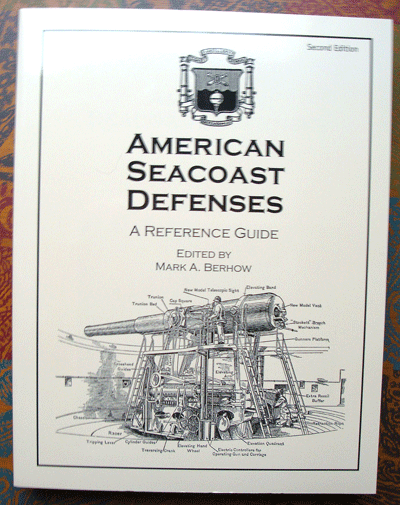
.
American Seacoast Defenses, a Reference Guide, 3rd Edition, Mark A. Berhow editor, CDSG Press, Acconeek, MD 2015 A reference work containing more specific details of the modern United States seacoast defenses (1890-1950) with sections on guns, batteries, fire control, mines, searchlights, radar, coast artillery organization, units, insignia, uniforms, lore, and more. Available in hard cover and PDF from the CDSG Press
The CDSG Publications News/Journal CD ROM: The CD ROM contains all the back issues of the CDSG News/Journal/Newsletter in the PDF format. It also has searchable table of contents to the remaining volumes. Available from the CDSG ePress.
For those of you interested in Air Defenses (1950-1978)—

.
Rings of Supersonic Steel: Air Defenses of the United States Army 1950-1979; an introductory history and site guide, By Mark L. Morgan and Mark A. Berhow, Third Edition, 2010, This work covers the development and deployment of US Army air defense gun and missile systems, including Nike-Ajax, Nike Hercules, BOMARC, and the Safeguard anti-ballistic missile system. The bulk of the work is a comprehensive guide listing all the sites where these systems were deployed. Available from Hole in the Head Press and other distributors.
Reprints of Key Historical Works on Seacoast Fortification from the CDSG Press
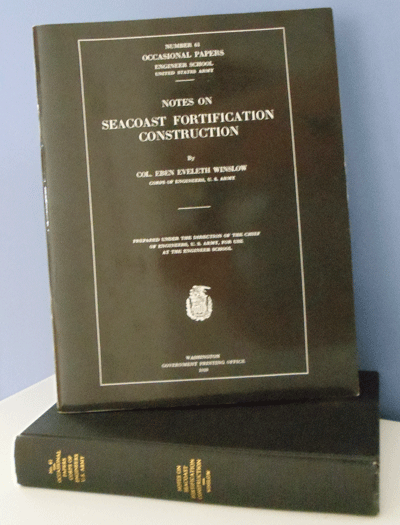
.
Notes on Seacoast Fortification Construction, by E.E. Winslow, Occasional Papers No. 61, Engineering School, United States Army, Govt. Pub. Office, Wash. DC 1920, reprinted CDSG Press, Bel Air, MD, 1994. An excellent primary source which surveys the construction of the early modern United States seacoast defenses (1880-1920), by an officer involved in the construction. The book discusses the historical background of seacoast fortifications, armor and armament, material used in construction of emplacements, ammunition supply and service, general design and details of the emplacements, ventilation, blast effects, electrical service, fire control, searchlights, and submarine mining. A hardcover reprint, with a separate paperback containing reproductions of the plates.
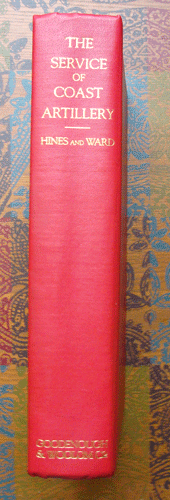
.
The Service of Coast Artillery, by Frank T. Hines, and Franklin W. Ward, Goodenough & Woglam Co., New York, 1910, reprinted by the CDSG press, Bel Air, MD, 1997 (hardcover, available from the CDSG Press). This text was prepared by two coast artillery officers and intended for new officers in the Coast Artillery Corps. It provides basic information on the weapons, tactics, and doctrine of the service dedicated to manning the seacoast defenses including definition of terms, theory and principles, organization and personnel, gunnery and ballistics, armament, projectiles, instruments, searchlights, submarine mining, engineering, and tactics.

.
American Coast Artillery Materiel (Ordnance Department Document No. 2042), Govt. Printing Office, Washington, D.C., 1923. An army publication that discusses and illustrates all the seacoast artillery weapons in use in 1922. This is one of the most comprehensive and profusely illustrated works on the specifics of early modern United States seacoast artillery weapons, though a number of weapons (obsolete by 1922) were left out. Sections include the history of the development of artillery, the design and manufacture of a 16-inch seacoast weapon, detailed descriptions of American seacoast guns and mounts, and several tables of weapon data.
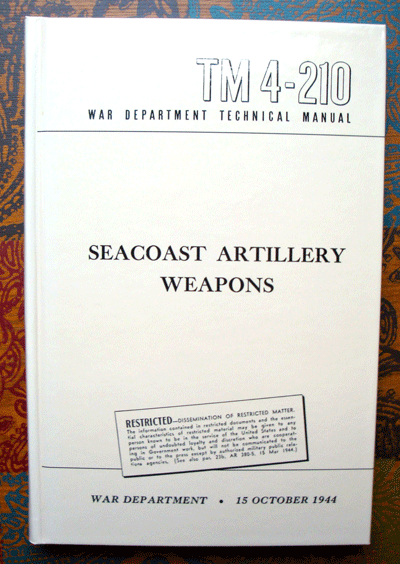
.
Technical Manual 4-210, Seacoast Artillery Weapons, War Department, Govt. Printing Off., Washington, DC, 1944, reprinted by the CDSG Press, Bel Air, MD, 1995. This publication describes and illustrates the seacoast artillery weapons used during the World War II years. Sections include cannons, recoil mechanisms, carriages, searchlights, and data on the characteristics of American seacoast artillery weapons.
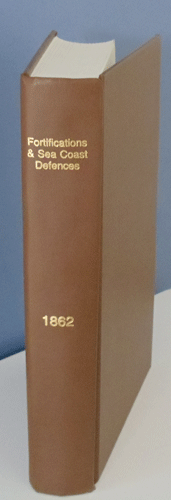
.
Permanent Fortifications and Sea-Coast Defenses: Congressional Report No. 62, U.S. House of Rep. (1862), Report of the Committee on Military Affairs. In 1862, the 37th Congress of the United States Committee on Military Affairs published a comprehensive report which reprinted a number of important previous reports dealing with fortifications from various time periods including Chief Engineer Joseph G. Totten’s 1851 report. They were basically narrative reports, with accompany charts and listings on subjects such as the fortifications erected at each site. “Permanent Fortifications” is the best one-volume source for information and explanation of “Third System” coastal fortifications.
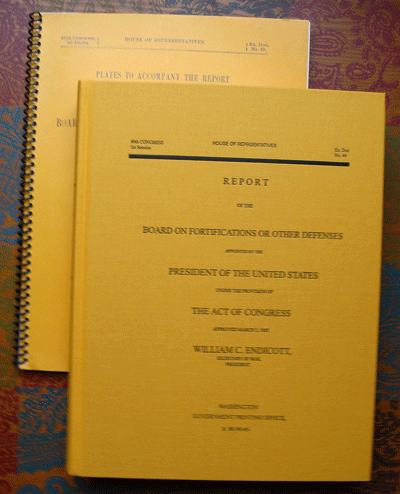
.
The Endicott Board Report was formally known as the Report of the Board on Fortifications or other Defenses Appointed by the President of the United States under the Provisions of the Act of Congress Approved March 3, 1885, House Executive Document No. 49, 49th Congress, 1st session (GPO, Washington D.C.,1886). This report marked the start of the modern era of the U.S. coastal defenses. This board report reviewed the state of American harbor defenses in 1885 and recommended a completely new system of harbor defenses based on the emerging technology of rifled breech loading cannons and armor. The major harbors of the U.S. were ranked in terms of military and economic importance. When Congress began to appropriate money for the construction of the new defenses in the late 1880s, this report was cited as the authorization source for the harbors to be defended. The Taft Board Report was formally known as the Report of the National Coast Defense Board . . . on the Coast Defenses of the United States and the Insular Possessions, Senate Document No. 248, 59th Congress 1st Session (GPO, Washington D.C., 1906). This report surveyed the progress in harbor defenses made since the Endicott Report and recommended a number of technical improvements. It also recommended the fortification of key harbors in the newly acquired overseas possessions such as Hawaii and the Philippines. Also included is the Report of the Board of Review of the War Department to the Secretary of War (November 26, 1915) on the Coast Defenses of the United States, the Panama Canal, and the Insular Possessions, House Document No. 49, 64th Congress, 1st Session (G.P.O., Washington D.C., 1916) which marks the transition from disappearing guns as the major weapon in American harbor defenses to the longer range 12- and 16-inch barbette carriage guns of the post World War I era. Available from the CDSG Press.
Other Books and Publications
Two if by Sea: the Development of American Coast Defense Policy, by Robert S. Browning III, Greenwood Press, Westport, CT, 1983. An excellent discussion of the political development of the American coast defenses 1780s to the 1910s.
Heitman, Francis B., Historical Register and Dictionary of the United States Army from its Organization September 29, 1789 to March 2, 1903. This has been reprinted several times recently.
Fortress America: The Forts that Defensed America, 1600 to the Present by Joe Kaufman is also good source of general location information.
Text books used by the US Military Academy:
- Ordnance and Gunnery, by Lawrence L. Bruff, John Wiley & Sons, NY, 1896 & 1902.
- Ordnance and Gunnery, by Ormond M. Lissak, John Wiley & Sons, NY, 1908 & 1915;
- Ordnance and Gunnery, by William H. Tschappat, John Wiley & Sons, NY, 1900s?;
- Ordnance and Gunnery, by Earl McFarland, John Wiley & Sons, NY, 1929 & 1932;
- Elements of Ordnance, by Thomas J. Hayes, John Wiley & Sons, NY 1938.
Photocopy reprints of several of these are available from the CDSG ePress and Military-Info.com.
Coast Artillery School Publications, Fort Monroe, VA. Coast Artillery Training Bulletins (CATBs) often went on to become Field Manuals; Army Extension Courses; Coast Artillery Weapons and Material Special Text No. 25, (1933 Edition); Fire Control and Position Finding for Seacoast Artillery (various dates).
Engineer Mimeograph Series. Another useful series, but unfortunately, very rare. Copies were printed and distributed to various offices, but few were preserved. The National Archives collection has been separated from their drawings and figures.
The Military Service Publishing Company, Harrisburg, Pennsylvania. This company printed a number of texts used by ROTC program and Army Extension Courses. They can be found at used book stores. Examples include: The R.O.T.C. Manual, Coast Artillery, Basic & Advanced, The Coast Artillery Corps: a Complete Manual of Technique and Material, and Seacoast Artillery, Basic Tactics and Techniques.
Key Congressional Reports, and Army Memos (Modern era)
Report of the Board on Fortifications or other Defenses Appointed by the President of the United States under the Provisions of the Act of Congress Approved March 3, 1885, House Executive Document No. 49, 49th Congress, 1st session (2 volumes, GPO, Washington D.C., 1886)–The Endicott Board Report. This is the start of the modern era of the United States coastal defenses. This board report reviewed the state of American harbor defenses in 1885 and recommended a completely new system of harbor defenses based on the emerging technology of rifled breech loading cannons and armor. The major harbors of the United States were ranked in terms of military and economic importance. When Congress began to appropriate money for the construction of the new defenses in the late 1880s, this report was cited as the authorization source for the harbors to be defended.Report of the National Coast Defense Board . . . on the Coast Defenses of the United States and the Insular Possessions, Senate Document No. 248, 59th Congress 1st Session (GPO, Washington D.C., 1906)–The Taft Board Report. This report surveyed the progress in harbor defenses made since the Endicott Report and recommended a number of technical improvements. It also recommended the fortification of key harbors in the newly acquired overseas possessions such as Hawaii and the Philippines. Note: the fortification of entrances to the Panama Canal was authorized in the Spooner Act of 1902.
Report of the Board of Review of the War Department to the Secretary of War (November 26, 1915) on the Coast Defenses of the United States, the Panama Canal, and the Insular Possessions, House Document No. 49, 64th Congress, 1st Session (G.P.O., Washington D.C., 1916). This report marks the transition from disappearing guns as the major weapon in American harbor defenses to the longer range 12- and 16-inch barbette carriage guns of the post World War I era.
Memo “Harbor Defenses,” War Plans Division, Office of the Assistant Chief of Staff, 8 Mar 1923, War Plans Division 1105. 18 pages. “This study, approved 17 Apr 1923, remained the basic definition of War Department policy with respect to Harbor Defenses until the eve of WW II.” (Note 2, page 45 in:Guarding the United States and its Outposts, the US Army in WW II, The Western Hemisphere, by Conn, Engleman & Fairchild, Center of Military History, US Army, GPO, Washington, DC, 1989). Memo “Harbor Defenses in the Continental United States,” War Plans Division, Office of the Assistant Chief of Staff, 6 Aug 31, AG 660.2 (9-30-31) War Plans Division 1105-55, 9 pages. This memo resulted in the creation of the Harbor Defense Board.
Documents pertaining to the 1940 Modernization Program for the Continental United States. This is some of the correspondence during study of Harbor Defense Board that was used to as the blueprint for the 1940 Harbor Defense Modernization Program. The July 27, 1940 letter recommending the building of “twenty-seven 16-inch batteries and fifty 6-inch batteries at major harbors around the continental United States,” is a key document. Additional overseas construction (Alaska, Canada, Panama, Hawaii, and the Caribbean) were added later, some as separate programs. Other letters were the official army authorization for various parts of the program.
US War Department, Letter: “Abandonment of Harbor Defense Posts no longer required for Sea Coast Defense,” Harbor Defense Board, President, AG 602 (7-27-40) M, 6 pages, Exhibit A (12 pages) contains the original list of batteries to be built beginning in 1941, Exhibit B (2 pages) (National Archives RG 407, Entry 360, Class. 602, Box 958).
Letters of Interest
- US War Department, Letter: “Modernization of Harbor Defense Projects, Continental United States,” AGO, AG 660.2 (9-16-40) M-WPD-M 26 Sept. 1940.
- US War Department, Letter: “Revision of Anti-Aircraft Annexes, Harbor Defense Projects,” AGO, AG 660.2 (10-23-40) M-OCCA 1 Nov. 1940.
- US War Department, Letter: “Surface Craft Detectors, SCR 296,” AGO, AG 413.68 (5-4-42) WC to the CG WDC 3 Nov. 1941.
- US War Department, Letter: “Defense of Harbors Against Motor Torpedo Boats AGO AG 660.2 (12-12-42) MSC-E to the CG WDC, 21 Feb 1942.
- US War Department, Letter: “Radio Set SCR-582 Central Surveillance Detector,” AGO AG 413.44 (12-12-42) MC to the CG WDC 13 May 1942.
- US War Department, Letter: “Revision of Underwater Defense Projects,” AGO, AG 660.3 (9-29-42) OB-S-E 20 Oct. 1942.
- US War Department, Letter: “Defenses of Harbors Against Motor Torpedo Boats,” AGO, AG 660.2 (4-12-43) OB-S-SPDDO-M, 17 Sept. 1943.
Annual Reports (Congressional Records)
These are often cited in CDSG Journal articles. These reports are part of the public record and the ones from the War Department are of particular interest to modern day researchers. These can be found at all major public libraries that are Federal record repositories. Some of the reports are separately bound.Annual Report of the War Department
Annual Report of the Chief of Engineers: At the conclusion of each fiscal year, the chief of engineers submitted a written report to the secretary of war, covering the military operations of the Corps of Engineers, work on fortifications, and rivers and harbor improvement. These reports, especially in the Endicott Era, are basic resources for anyone researching seacoast defenses. Until 1922, these reports were published in the annual report of the secretary of war. The CDSG ePress has a series of PDF files that have been copied from the National Archives.
Annual Report of the Chief of Ordnance
Annual Report of the Chief of Artillery, Chief of Coast Artillery: At the conclusion of each fiscal year, the chief of artillery (1901-1907) and chief of coast artillery (1908-1937) submitted a written report to the secretary of war, covering the military operations of the Corps of Artillery/Coast Artillery. These reports are basic resources for anyone researching seacoast defenses. The CDSG ePress has a series of PDF files that have been copied from the National Archives.
